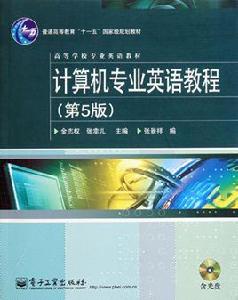圖書信息
叢書名: 高等學校專業英語教材
平裝: 407頁
正文語種: 英語
開本: 16
ISBN: 9787121140518, 7121140519
條形碼: 9787121140518
尺寸: 23.2 x 18.6 x 1.6 cm
重量: 599 g
內容簡介
《計算機專業英語教程(第5版)》(作者金志權、張幸兒)為普通高等教
育“十一五”國家級規劃教材,旨在使讀者了解計算機領域的新進展,了解
和掌握最新和常用的專業英語術語。期望讀者通過本教程的學習,鞏固和擴
大計算機專業知識面,能培養和提高閱讀與筆譯專業英語文獻資料的能力,
並達到會看、會聽、會說和會寫的英語四會能力。
《計算機專業英語教程(第5版)》內容新穎、覆蓋面廣、結
構合理、系統性強、可瀆性高。為了方便讀者,本書配有光碟,內容包括單
辭彙總、縮略語與術語索引以及部分音頻和視頻素材等。為了方便教學,本
書另配有教學資源,向採用本書作為教材的教師免費提供。
本書可以作為高等院校計算機專業的專業英語教材,也可供計算機專業
人員或其他有興趣的讀者學習參考。
目錄
Unit 1 Hardware Ⅰ
1.1 A Closer Look at the Processor and Primary Storage
1.2 Bus Interconnection
1.3 Integrated Circuit—Moore’s Law
1.4 Multicore Processors
1.5 Computer Architectures
Unit 2 Hardware Ⅱ
2.1 Optical Storage Media: High?Density Storage
2.1.1 Optical Laser Disks
2.1.2 DVDs
2.2 Display devices, Smart cards
2.2.1 Display devices
2.2.2 Smart card—another type of storage system
2.3 RAID Technology
2.4 The External Interface: USB
Unit 3 Programming and Programming Languages
3.1 Computer Programming
3.2 C and Object?Oriented Programming
3.3 JavaScript Tutorial
3.4 Introduction to Java
3.5 Characteristics of Web Programming Languages
Unit 4 Operating System
4.1 Summary of OS
4.2 Using The Windows Operating System
4.3 Window Managers
4.4 Myths of UNIX
4.5 Using Linux in Embedded and Real?time Systems
Unit 5 Computer Networks
5.1 Internet
5.2 Type of Connection
5.3 Extending Your Markup:An XML Tutorial
5.4 Network Protocols
5.4.1 Protocol Hierarchies
5.4.2 WAP—The Wireless Application Protocol
5.5 Web 2.0, Internet2
5.5.1 Web 2.0
5.5.2 Internet2
Unit 6 Network Communication
6.1 Two Approaches to Network Communication
6.2 Carrier Frequencies and Multiplexing
6.3 Wavelength Division
Multiplexing:Ultra High Speed Fiber Optics
6.4 Wireless Network
Unit 7 Database
7.1 An Overview of a Database System
7.2 Introduction to SQL
7.3 Object?relational Database
7.4 Data Warehouse
7.4.1 Data Warehouse
7.4.2 What is Data Mining
7.5 Universal Data Access (UDA) Overview
Unit 8 Multimedia
8.1 Introduction
8.1.1 Main Properties of a Multimedia System
8.1..2 Multimedia
8.2 Audio
8.2.1 Computer Representation of Sound
8.2.2 Audio Formats
8.2.3 MP3 Compression
8.3 Video
8.3.1 Video Compression
8.3.2 MP4
8.4 Synchronization
8.5 An Introduction to Desktop Conferencing
Unit 9 Artificial Intelligence
9.1 Overview of Artificial Intelligence
9.2 About Expert System
9.3 Introduction to Game AI
9.4 Neural Networks
9.5 Industrial Robotics
Unit 10 Data Structure and Algorithms
10.1 Abstract Data Types and Algorithms
10.2 Spanning Trees
10.3 Block Sorting Algorithms:Parallel and Distributed Algorithm
10.4 Divide?and?Conquer
Unit 11 Fundamentals of the Computing Sciences
11.1 Set Theory
11.2 Predicates
11.3 Languages and Grammars
11.4 Finite?State Machines
Unit 12 Computer Applications Ⅰ
12.1 Computer?Aided Design
12.2 Introductory Overview of CIM
12.3 Management Information System(MIS)
12.4 Enterprise Resource Planning
Unit 13 Computer Applications Ⅱ
13.1 Distance Education Technological Models
13.2 Electronic Business
13.3 E?Government —Introduction
13.4 Office Automation
Unit 14 Cumputer Applications Ⅲ
14.1 Geographic Information Systems(GIS):A New Way to Look at Business Data
14.2 Introduction to GPS
14.3 The Virtual Reality Responsive Workbench
Unit 15 Software Development
15.1 Overview of Software Engineering
15.2 Unified Modeling Language
15.3 Overview of the Capability Maturity Model
15.4 Requirements for the Next Generation Methods and CASE Envir
onments
15.5 Agile Software Development Methods
Unit 16 Network Security
16.1 What Do I Need to Know about Viruses?
16.2 Modern Cryptography?Data Encryption
16.3 Firewalls and Proxies
Unit 17 Some Computer Systems
17.1 Embedded Systems
17.2 Distributed Systems
17.3 Middleware
參考譯文
1.3 積體電路——摩爾定律
2.3 廉價磁碟機冗餘陣列技術
2.4 通用串列匯流排
3.2 C+和面向對象的程式設計
4.4 UNIX的神話
4.5 在嵌入式和實時系統中使用Linux
5.5.1 Web 2.0
6.1 網路通信的兩種方法
6.4 無線網路
7.1 資料庫系統概述
7.5 通用數據訪問(UDA)概述
8.3.1 視頻圖像壓縮
8.5 桌面會議介紹
9?2 專家系統
9.4 神經網路
10.3 塊排序算法:並行和分散式算法
10.4 分治法
11.2 謂詞
13.1 遠程教育技術模型
14.1 地理信息系統(GIS):查看事務數據的新方法
14.3 虛擬現實回響工作檯
15.4 下一代方法和CASE環境的需求
16.2 現代密碼學——數據加密
16.3 防火牆和代理

